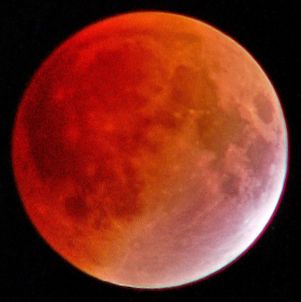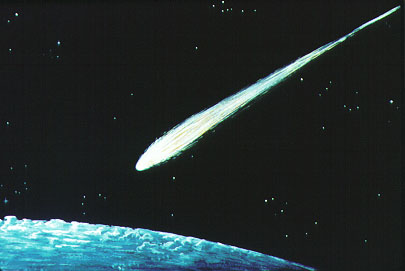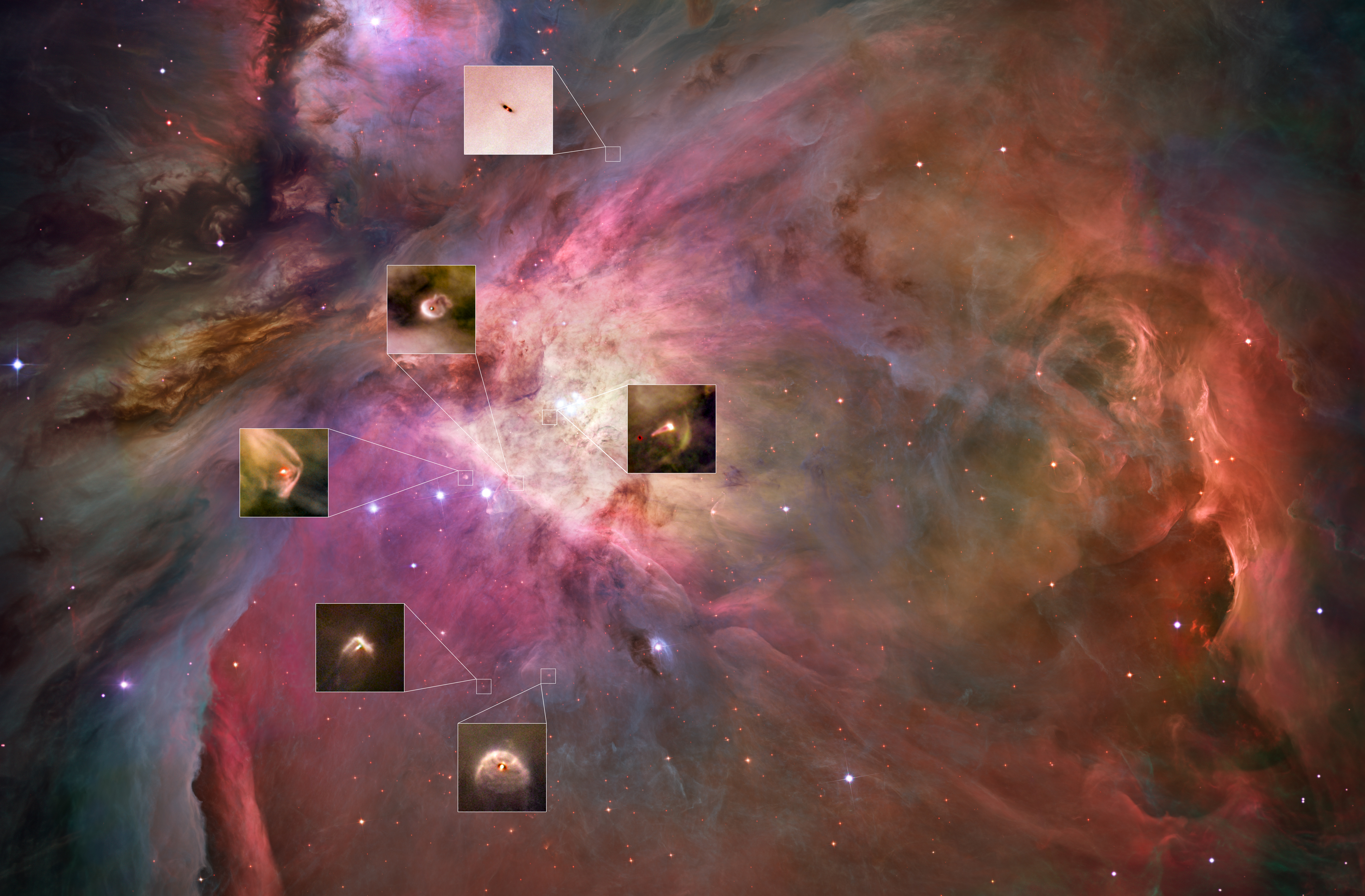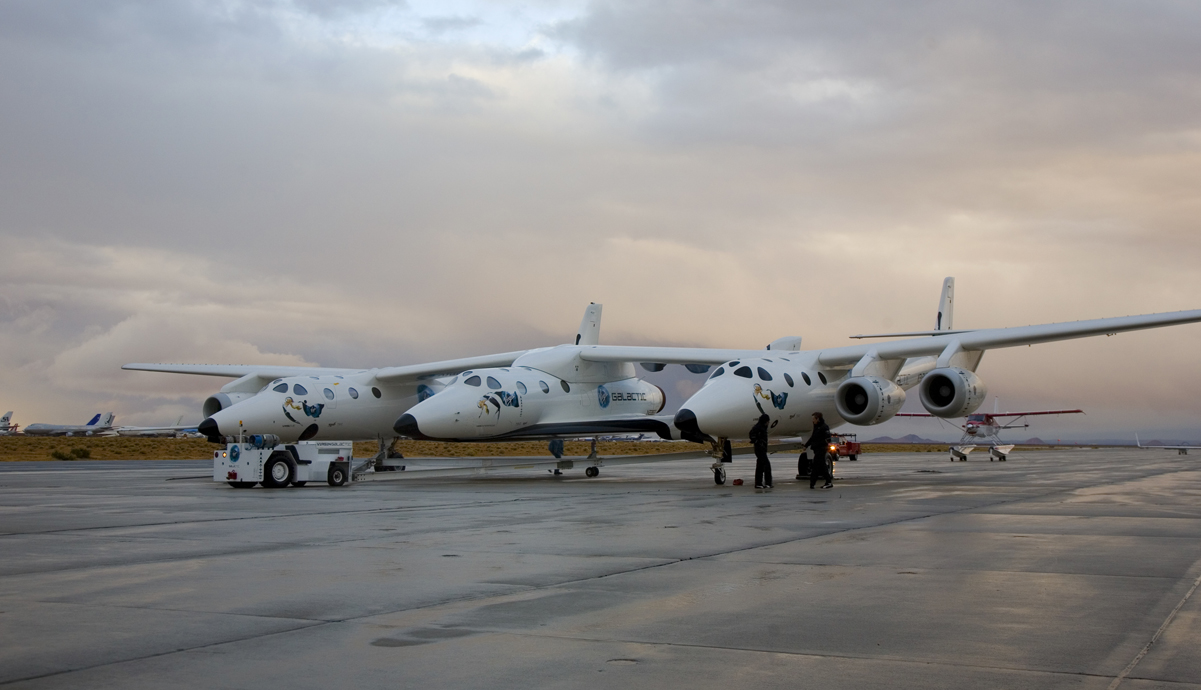2009-12-28
Europe Gets An Eclipse
This New Years Eve, Thursday 31st December 2009, most of Europe will experience a partial eclipse of the Moon. Beginning at 17:17:08 UT, the Moon will enter the Penumbral shadow of the Earth and very subtly start to darken. At 18:52:43 UT the Moon will begin to enter the Umbral shadow of the Earth, the point at which the Moon will glow in the classic orange and red colors. Since this is a partial eclipse, the Moon will not completely enter the Umbral shadow. The greatest depth of shadow will occur at 19:22:39 UT.Graphic depicting the shadow of the Earth
So, doesn't it glow all orange, and stuff?
Yes, it does! One of the most fascinating aspects of a lunar eclipse is the deep orange and red colors that are seen as it enters deeper and deeper into the shadow. The colors are actually caused by the ring of permanent sunrises and sunsets that constantly encircle the Earth, as it is always sunrise or sunset somewhere. The Moon is far enough away to be able to see this ring as a bright orange and red circle once it is inside the full umbral shadow, bright enough in fact to illuminate the surface of the Moon. Imagine for a moment actually standing on the surface of the Moon when this happens, looking up to see planet Earth as a ring of fire in the sky, and looking down to see the once bright white surface flooded with deep reds and oranges. With the discovery of water on the Moon, and the subsequent increase in interest that event caused, it won't be long until we are back there on a permanent basis. The day when we witness such a spectacular event in person may not be that far away.
The Blood Red Moon during the August 16th 2008 eclipse
As can be seen in the image above, sunlight is refracted through the edge of the Earth's atmosphere giving rise to a spectacular lunar light show. If you are in Europe, and happen to be graced with clear skies, it is a sight well worth catching. Even though it is a partial eclipse, there will still be a long period of deep orange colors, making it possible to view even in partially cloudy conditions.
Happy Mooning, Spacers!
SpaceHead
Images credit: Sagredo, Tomruen
2009-12-26
A Year In Highlights
The events of 2009 at NASA have been summed up in a video just released by the agency.Let's look forward to a 2010 that is just as full of Space!
SpaceHead
2009-12-24
Watch For A Fireball Tonight
So, isn't there some kind of cosmic event tonight, then?Well, yes there is. Tonight marks the beginning of a traditional holiday known as Christmas, where a white bearded overweight benevolent man named Santa Claus will be travelling through the atmosphere so blindingly fast that he will vaporize the air he flies through. Why would he do this? Well, to deliver gifts to every child on the planet, of course!
Santa Claus burning up the atmosphere on Christmas Eve
Old Saint Nick, or Father Christmas, or just plain old Santa, as he's known, will use a little studied propulsion technology known as Nuclear Reindeer, with a bizarre red nose based guidance system called Rudolph. The number of children actually covered under the service agreement varies dependant on several criteria, not least of all an index of goodness which is applied to each child and administered by a vision system Santa wears throughout the year that automatically logs naughty behaviour. Global Climate Change is often adversely affected by a high instance of naughty children, who are rewarded for their transgressions with lumps of coal. The bakery and dairy industries across the planet are taxed to their structural limits as Saint Nick uses a Mr. Fusion unit to convert cookies and milk collected from the houses he visits along the way into reindeer fuel.
NASA has yet to detect the fireball created by Santa's travels, although this is likely the result of a high instance of excited children throughout the homesteads of NASA personnel. This doesn't mean you shouldn't at least try to catch a glimpse of the flaming Santa Claus in the sky though, as apparently the wake he leaves behind is felt for months after - or at least until the decorations fairy comes along to switch off all those annoying twinkly lights!
Merry Christmas, Spacers!
SpaceHead
Image credit: NASA
Spirits High For Rover Rescue
The Spirit rover on Mars has been stuck in soft ground since April and has endured two failed attempts to free it, but now hopes are high after data from a third attempt showed the stuck wheel turning once again and giving significantly more traction than before. The soft area has been dubbed "Troy", after the ancient city that mired the Greeks for 10 years.Spirit uncovers a wealth of information at Troy
Spirit has not been just sitting around during its stuck time, it has been performing scientific test of the area and recently discovered the soil had a crust, indicating variations in climate over millions of years. This discovery alone points to Mars having a more active past, and with so much data gathered from one spot, Troy will be analyzed for some time even after the rover leaves - if the next rescue attempt is successful of course.
Watch out for updates as the rescue continues.
SpaceHead
Image credit: NASA/JPL-Caltech
2009-12-22
Soyuz Docks To Station
Spacers UpdateNASA astronaut Timothy (T.J.) Creamer, Russian cosmonaut Oleg Kotov, and Japanese astronaut Soichi Noguchi docked their Soyuz capsule to the International Space Station at 5:48pm EDT. Hatches are scheduled to be opened at 7:35pm EDT, after comprehensive leak checks are performed to ensure a solid seal between the Soyuz and the ISS.
Their arrival marks the return to a five person crew aboard the station, which has been manned by a crew of two since the departure of the previous Soyuz at the start of December.
[update: 7:30pm EST] Hatches are open.
[update: 7:35pm EST] T. J. Creamer enters the station wearing an elf hat ears. Cosmonaut Oleg Kotov enters the station wearing a Santa hat carrying a wreath. Soichi Noguchi enters wearing a Santa hat and is carrying a bag of presents over his shoulder.
SpaceHead
2009-12-21
E=MC² A Hoax - Einstein Hid The Decline!
Folks, did you ever think to yourself that something didn't smell right about E=MC²? Well you were right, it's all a big hoax! And I didn't even have to crack private emails to find this one, it was blatantly obvious, right there in Einstein's theory of general relativity... a fudge factor, an admission that it didn't all add up, an in your face attempt to "hide the decline". One would expect such a so called "great scientist" to cover up such blatant dishonesty, right? No, wrong. He laughed in our faces and even gave it an outright sciencey sounding name - the Cosmological Constant. Who do you think you're kidding, Albert!This charlatan of a man makes stuff up
So, you've got evidence for this, right?
Well, not as such, no. Aside from a few off the cuff mentions and quotations, there's no actual record of Einstein admitting it's all a big fraud in any correspondence, so I've had to make some stuff up that you betcha will be right if we were to travel back in time and be a fly on the wall. And anyway, just like you don't need evidence to prove Anthropogenic Global Warming is false because that's a negative and you can't prove a negative, you can't prove Einstein didn't say this because that's a negative too!
Here's a snippet from a letter he might have written about it: "I've just completed Edwin's telescope trick of adding in the real movement of the galaxies to hide the decline." - Albert Einstein (made up, but probably real).
Wow! I mean, WOW! He is obviously talking about the galaxies declining away from us as observed by Edwin Hubble, which totally exposes his fraudulent cosmological constant for the fakery and trickery that it is. Shame on you, Albert!
This mumbo-jumbo was the biggest hoax of the 20th century
So, isn't gravity just a pile of crock too, then?
Yes, absolutely! I have always had my suspicions about this whole theory of gravity as being all warped space and twisty graphs with bowling balls falling in to bottomless pits. I mean it all sounds make up and fake and fraudulent and stuff, right! Gravity is the result of Magical Pressing®, a force that I have spent years researching and now that I have dispatched the one last obstacle to my theory, Mr. Einstein, I can now sell my special Grav-Oil® - an anti-gravity elixir that is actually able to make you fly, just so long as you really, really, really believe that it will. Available now at the special introductory price of $49.99 for a liter bottle, and it comes it three great flavors, Apple, Cinnamon, and Anthropogenilicious® - a blend of freshly picked cherries and modern banana.
There are no refunds offered for Grav-Oil®, but the more you drink it, the more likely you are to believe it actually works. Tests have shown that it can take up to ten bottles to truly believe, although skeptics may need to get colonic irrigation if prolonged failure persists. Spacers is not responsible for any injuries acquired in the unlikely event flying should occur.
Happy Flying, Spacers!
SpaceHead
2009-12-20
ISS Replacement Crew Launches
Three new crewmembers for the International Space Station launched today on board a Soyuz rocket from the Baikonur Cosmodrome in Kazakhstan. Timothy J. Creamer, Oleg Kotov and Soichi Noguchi will join Jeff Williams and Maxim Suraev, the two crew already on board the station, who watched an uploaded video of the launch.Soyuz launch carrying the ISS crew
The three new crew will remain on the station until May and will play host to two Space Shuttle missions, one of them bringing a brand new module, Node 3, or Tranquility, a large connecting node which will come complete with a 7 window Cupola promising to give the crew on board incredible new panoramic views of the Earth and space.
When the new crew arrives on Tuesday they will complete the Expedition 22 roster, one of several interim 5 person crews that will occupy the station until the Soyuz launches sync up after the end of Shuttle crew transportation, which historically rotated a sixth crew member. When Williams and Suraev depart the station in March, Kotov will take over as commander and the crew will officially become Expedition 23.
Watch out for the docking on Tuesday, scheduled for 5:58pm EDT.
SpaceHead
Image credit: NASA/Bill Ingalls
2009-12-18
Fly Through The Known Universe
A stunning video has been released by the American Museum of Natural History that very graphically illustrates our known universe in the form of a fly-out from Earth to the edge of the universe - and back again.If you ever have a need to feel small, watch this in HD.
Happy Traveling, Spacers!
SpaceHead
2009-12-17
Ice Twice!
Thanks to Phil Plait over at Bad Astronomy for pointing out something very interesting and cool - the iceberg floating near Australia is actually bigger than a lump of ice recently discovered in old Hubble data.First of all, lets look at what Hubble saw. All data from the space based telescope is logged and recorded, including data from its on-board star tracking system, which is essentially software that keeps it oriented by looking at known stars and locking the position of the telescope using orientation software. When astronomers recently went back through data from the the last 4.5 years from the tracker, they found a blip that looked very much like an object had passed in front of the star it was looking at. After further analysis, they found it was a Kuiper Belt object. The Kuiper belt - as Phil puts it, is the torus of icy comet nuclei orbiting the Sun out past Neptune.
Visualization of Hubble seeing the object
Wow! The cool thing is that the object turns out to be a little over a kilometer in size, making it by far the smallest Kuiper Belt object ever observed.
Second, let's take a look at the iceberg, which is currently breaking up and melting in the Indian ocean.
The drifting iceberg from space
Note the scale at the bottom left of the image - that thing is 25 kilometers in size!
So, the cool thing is that the object recently discovered by Hubble is much smaller than the iceberg, and since the object is about 4.6 billion miles away, I think that is one achievement that Hubble can be very proud of.
Happy Freezing, Spacers!
SpaceHead
Images credit: NASA, ESA, and G. Bacon (STScI) and NASA Earth Observatory
2009-12-16
Sunspots!
Our closest star, the Sun, has been without sunspots for some time now, but after a false start earlier this year it has sunspots again. In the latest image taken today by the SOHO (SOlar and Heliospheric Observatory) satellite, a group of several sunspots can be clearly seen.Sunspots appear again on the Sun
Over the last few years the Sun has been in the low ebb of its 11 year magnetic cycle, which means the absence of sunspots was entirely normal. The actual cycle is 22 years long with a flip of the magnetic poles at the lowest point every 11 years. The cycle time does vary, but this time it has been over a year since the excpected return to sunspot activity. The Sun is a complex cauldron of stormy gasseous fusion that we are still learning about, so variation in expected behaviour adds a lot to our knowledge of its workings.
Sunspots are caused by a very simple phenemenon called magnetic turbulence. As the magnetic strength of the Sun increases, so does turbulence in its magnetic flow lines. Just like the flow lines seen using a regular magnet and iron filings, the Sun radiates giant magnetic loops from pole to pole. When turbulence increases to a point where it can disrupt the flows, a tortured and wrenched flow line breaks from its regular positon and crashes into the surface, ripping holes in the hot outer layer and creating cooler patches. It is these cool patches that we see as sunspots.
You can keep an eye on the daily activities of the Sun at the SOHO website: http://sohowww.nascom.nasa.gov/home.html
Happy Sunspotting, Spacers!
SpaceHead
Image credit: STEREO, SOHO, NASA/ESA
2009-12-14
Hubble Spies Planets Forming In Orion
A series of images just released from the Hubble Space Telescope of the Orion Nebula reveal a remarkable array of Proto-Planets, or Proplyds, which are planetary systems caught in the act of forming. A total of 30 close-up views in all providing the best insight yet to how the process works. It is thought that our Earth formed in similar circumstances as gas from a massive nebula collapsed to give birth to our Sun.Proto-planetary discs in close-up in the Orion Nebula
By itself the Orion Nebula is a stunning sight, as can be seen in the above image. Adding the detail of planet formation brings it to life as a fully functional stellar nursery. The incredible colors are the result of the gas and dust being lit up by the star Theta 1 Orionis C, but look closer as Hubble has done and you can clearly see holes punched out by young stars, which are themselves surrounded by gaseous discs. Over time the dust in these discs condenses to form clumps, which then collide to form heavier and larger clumps, and eventually rocky masses. The process is called accretion, and as the collisions continue larger and larger rocks form and become small planetoids. It is a violent time around the star, and as the material forms into ever larger objects, planets and moons arise. The gas is attracted to the rocks as they gain size and gravity. Some form simple atmospheres, while others become gas giants.
With such a rich environment to study there are other incredible sights, like bow shocks ahead of stars as they travel through the nebula. Our Sun is thought to have been ejected from an environment like this a few billion years ago, but even in its relatively open setting we do still have a bow shock, an area where the pressure of the material from the Sun is equal to the pressure of the interstellar gas. This area is known as the Heliopause, and is compressed in the direction we are traveling to form a teardrop shaped bubble called the Heliosphere. Within the much higher pressure of the Orion Nebula, bow shocks are seen far more prominently.
The video below is a fantastic 3D journey into the core of Orion and shows many of the bow shocks. The animation is based on actual Hubble data and the positions of the stars are as accurate as possible.
http://imgsrc.hubblesite.org/hu/db/videos/hs-2001-13-a-low_quicktime.mov
Check out the Hubble site for more images and videos
http://www.spacetelescope.org/news/html/heic0917.html
SpaceHead
Image credit: NASA, ESA, M. Robberto (Space Telescope Science Institute/ESA), the Hubble Space Telescope Orion Treasury Project Team and L. Ricci (ESO)
Moonsteps Spotted From Orbit
Yes, we went to the Moon. Yes, we left footsteps. Yes, we've got some kickass hardware up there now taking pictures that prove it. The LRO (Lunar Reconnaissance Orbiter) has been patiently mapping the surface of the Moon since June at a resolution previously unprecedented. Earlier in the year the NASA LRO team release pictures of several of the Apollo landing sites, and now they have just released a picture of the Apollo 12 landing site that clearly shows the tracks of the astronauts' footsteps.LRO image of Apollo 12 landing site
Wow, now that's some serious resolution! Click it to get the bigger picture. It even shows the Surveyor 3 probe that was launched 2 years before. The Apollo 12 landing site was chosen to test the level of landing accuracy that could be achieved, and since they landed right beside the target it was considered a complete success.
In the image above the footprints left by astronauts Pete Corad and Alan Bean can be clearly seen, which is pretty damning evidence that we actually walked there. There will of course still be those who will deny and call into question the validity of the image, but as can be seen with this and the likes of global warming, denial is a very popular passtime. I'll bet that even once we return to the Moon and have ground level handheld HD images of the actual original footprints being beamed back by the new astronauts, there will still be a chorus of denial. A cursory knowledge of science is all that it takes to find conclusively that a significant amount of the knowledge we have about the Moon today is simply not possible to know without having a man set foot on the actual surface.
We really did go there, and we really are going back. It's just not soon enough for me, but that's because I'm a die-hard space geek. Maybe the recent discovery of water on the Moon will kick the required butts into action. Or maybe the new found interest of many other nations in the Moon, like China for example, will spark another space race. I'm no fan of the flags and footprints strategy, but maybe this time we'll take the longer term exploration goal to heart and set up a permanent presence there. We need to start getting out there and exploring, and the Moon is a perfect place to start.
SpaceHead
Image credit: NASA/Goddard Space Flight Center/Arizona State University
2009-12-13
WISE Up!
Spacers QuickieNASA launches the WISE telescope tomorrow at 9:09am EST. WISE (Wide-field Infrared Survey Explorer) is set to launch atop a Delta II rocket and will be an incredible addition to our collection of space-based observatories. The resolution of WISE is so fine that it is expected to detect hundreds of millions of objects from galaxies down to asteroids in our solar system.
Catch the launch on NASA TV.
Happy Launching, Spacers!
SpaceHead
2009-12-11
Ascent Highlights
This is just made of awesome - the STS-129 ascent footage and imagery has been edited and set to music in a stunning 12 minute video. Curl up with a beverage of your choice, full screen it and crank up the subwoofer for that chest thumping launch sound.I hope all future Shuttle launches are given this treatment.
Enjoy!
SpaceHead
Swirly Thing Alert!
So, those photographs of a huge swirly thing in the sky over Norway are fake, right?Actually no. They are real! Yeah, I know, my first reaction was you've got to be kidding me. I tried my best to not read the text explaining it because I just knew I could figure it out... it was a... no, maybe it's a... oh, could it be a... no, it couldn't be that. I knew it was real, but what the heck was it?
Want to have a guess yourself? Take a look at the image below (click for big-ness) and don't read any further until you have guessed. Good luck!
Yes, this is a real photograph!
I couldn't resist any longer, I just had to know. As it turns out this is a missile test that failed as the second stage ignited. The blue cone poking out of the center is the exhaust plume, and the spiral is material being ejected as it spins out of control - lit up by the rocket burning out. Yesterday morning Moscow papers reported on the Norway photos and videos and about the speculation that it's a failed Bulava launch, but the state controlled TV channels have been remarkably quiet on the issue. Silence is golden where military failures are concerned, I suppose.
This clip from CBS sums it up nicely.
Happy Swirling, Spacers!
SpaceHead
Image credit: Odd Magne Haugen
2009-12-10
Virgin Unveils Suborbital Spaceliner
When SpaceShipOne won the $10 million Ansari X-Prize back in 2004 it was anticipated that commercial suborbital spaceflight would be a reality within a few years. This reality has now been solidified with the unveiling of SpaceShipTwo, the first Virgin Galactic suborbital vehicle under the wings of its carrier WhiteKnightTwo. The event took place at a very stormy Mojave Air and Space Port on Monday.SpaceShipTwo attached to WhiteKnightTwo
So, can I actually go in to space then?
You can go in to suborbital space, yes - if you have got a cool $200,000 sitting around in pocket change. Beginning as early as 2011 Virgin Galactic will be doing just that - sending paying customers to the edge of space and giving them the thrill of being weightless for several minutes and seeing the curvature of the Earth from above the atmosphere. With over 300 passengers already stumping up the 200k for a flight, the line is getting longer and production of the vehicles is projected to reach 40 within a few years, but Virgin Galactic has sealed its place in the historic first flights with exclusivity on launches for the first 18 months, so don't be expecting the lines to get smaller anytime soon.
SpaceShipOne and SpaceShipTwo comparison
By the time the flights are ready to go, New Mexico will have completed construction of Spaceport America, a state of the art facility designed to be a model for future spaceports across the US. The cost will of course come down as the number of flights increases, but it will be a long time before spaceflight becomes anything like air travel, with low cost carriers saturating the marketplace.
I have put a huge empty vodka bottle in the corner, so come on Spacers, turn out your pockets and send your change to me so I can send a Spacers report - from actual space!
Happy Spacing Spacers!
SpaceHead
Images credit: Virgin Galactic
2009-12-04
Climate-Gate: Conspiracy, Or Just Poor Argument
I don't often get off the subject of space or wax political about anything, but the recent so-called "climate-gate" affair involving hacked emails from climate scientists has piqued my curiosity - although since climate science involves the use of satellites it's technically still about space...So, what's all this about then?
Recently, thousands of emails between a group of climate scientists going back over the last 13 or so years were hacked. Climate change "deniers" picked up on two seemingly suspicious phrases within the emails and claimed they alone invalidate decades of climate science that overwhelmingly points to a warming planet caused by the activity of man. Yep, that's right, from thousands of private emails, two phrases were removed from context and presented as the death blow to climate change theory. Now color me skeptical (chortle chortle), but you have to be pretty desperate about the chances of your argument to wield such a tiny piece of fluff as the ultimate weapon of Armageddon.
These are the two phrases in question:
"I've just completed Mike's nature trick of adding in the real temps to each series for the last 20 years (ie from 1981 onwards) and from 1961 for Keith's to hide the decline." - Phil Jones, Director Climate Research.
"The fact is we can't account for the lack of warming at the moment and it is a travesty that we can't." - Kevin Trenberth, Climate scientist.
This is the best evidence they could find of widespread fraud about climate change from thousands of emails over 13 years. This is the evidence of a conspiracy. The word "trick" is widely used in science to denote an innovative or clever method of analyzing data. Tricks that work go on to become regularly used methods in successful theories. The word is in no way indicative of fraudulent activity. Not being able to account for something is not unusual in science, and it quickly becomes an invalid statement once something is found to be accountable. As evidence of fraud, this is an EPIC FAIL!
So aside from the inanity, let's give it a little bit of context. Imagine a collection of letters was discovered by Sir Isaac Newton, and in those letters he revealed he had to play about with some numbers to make his equations about gravity work properly. Proof that gravity is a hoax, right? Well, no it isn't. All it proves is that it took some work to come up with a valid theoretical construct to accurately describe the facts of gravity. Now of course Newton's theory has been mostly superseded, but any invalidation was the result of new evidence and research, not by isolating his tribulations as a scientist. The same applies to climate theory; any invalidation will have to come from evidence and research, not from sensationalizing a few errant quotes mined from a mountain of private chatter between people in the midst of a scientific process.
So, is global warming all a big fraud then?
Of course not. Just as the theory of gravity is an ever-evolving logical construct that we use to describe and act upon the facts of gravity, so is climate theory an ever-evolving logical construct that we use to describe and act upon the facts of climate change. I do of course grant that climate theory and the theory of gravity are not as well supported by facts as the theory of evolution, but that in no way makes them any less viable. If I drop an apple, it falls to Earth - fact. Opposable thumbs have traceable evolutionary lineages - fact. Burn a fossil fuel and I contribute to trapping heat in the Earth's atmosphere - fact. These facts remain, whether I like them or not, and more importantly whether I agree with them or not - for all I gain by disagreeing with them is the right to call myself a denier.
Phil Plait at Bad Astronomy said it perfectly on his blog: "You may not like it, but in modern climatology, global warming is accepted as the standard. It’s not up to me or anyone to prove it right at this point, it’s up to scientists to show it’s wrong. To do that you’ll need a lot of really good evidence, and from what I have seen and read that evidence is not there [in the emails]." And I agree with him completely when he says: "I don’t cling to AGW because of political bent or any ideology. I think global warming is real because of the overwhelming evidence pointing that way."
Phil's post is a very informative read on the subject. http://blogs.discovermagazine.com/badastronomy/2009/12/04/global-warming-emails-followup/
I rarely get opinionated, but this kind of nonsense snaps something in my happy place and I just have to do something to fix it. Much as I would love to, I can no more deny that Anthropogenic Global Warming is a reality, than I can deny that there are people who think money spent on space exploration is actually spent - in space. It would please me no end to find that Global Warming was a massive hoax, because despite the fact that it is littered with whackaloons and nutjobs, I actually have something of an affinity with my species. I think we have incredible potential - if we can just weed out the whackaloons and nutjobs.
Try not to stay too globally warm, Spacers!
SpaceHead
2009-12-03
Mars Rover Still Stuck After Wheel Stall
Beleaguered Mars rover Spirit is still stuck in a patch of soft sand after another attempt by NASA to free it ended with a wheel stalling. This time though, the stall is suspected to be because of a technical problem with the wheel actuator itself. A previous attempt where the wheel stalled gave engineers the impression that the wheel was actually spinning in the soft sand, which caused them to abort the attempt.Spirit stuck in sand
Rover project engineers are developing diagnostic tests to explore the health of the wheel actuator and to isolate any interactions that could have potentially been caused by terrain. NASA is taking its time to analyze and plan the next move, which will hinge on the results of the diagnostic tests.
According to the NASA JPL website, the rover has moved as a result of the rescue attempts. The details of the movement are: the rover has performed 9.5 meters (31 feet) of wheel spin and the rover's center, in total, has moved 16 millimeters (0.63 inch) forward, 10 millimeters (0.39 inch) to the left and 5 millimeters (0.20 inch) downward.
All very well, but to me the "downward" movement is a little on the ominous side - sounds more like digging in deeper. Spacers wishes the JPL team and Spirit good luck in the next attempt.
SpaceHead
Image credit: NASA/JPL-Caltech
2009-12-01
ISS Buzzed As Crew Lands
A small 10cm piece of Russian rocket debris buzzed within a kilometer of the ISS today, but mission managers were unconcerned. Orbit projections showed that the debris would not pose a threat to the station and stood down plans to have the crew on board take refuge in their Soyuz escape capsule in case they had to make an emergency evacuation.Orbital debris is a constant problem for the International Space Station, with so much junk polluting Low Earth Orbit that NASA must track each one and keep a vigilant eye on possible collisions. Despite three recent close calls, the outlook for the ISS is fairly stable for the immediate future.
Soyuz capsule landed in Kazakhstan
Before the drama, three of the five crew departed the station on their planned return to Earth after six-months in space, leaving just two occupants aboard the multi-billion dollar outpost. American commander Jeffrey Williams and Russian flight engineer Maxim Suraev will be joined by three more crew in late December when a Russian Soyuz launches a replacement crew.
SpaceHead
Image credit: Roscosmos/NASA TV
Subscribe to:
Posts (Atom)



















